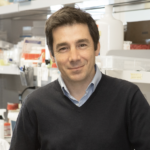Thursday, May 1, 2025
| 17:30 – 19:00 | Mark Wainberg Lecture – Dr. Winston Husbands
Beyond Appeasement: HIV, Health and the Promise of Black Emancipation |
Friday, May 2, 2025
| 09:00 – 9:45 | Basic Sciences Plenary Session – Dr. Nicolas Chomont
Curing HIV: Turning Our Dream Into Reality? |
| 09:45 – 10:30 | Epidemiology & Public Health Plenary Session – Dr. Lawrence Mbuagbaw
Together for Change: Sustaining HIV Research and Equity |
Saturday, May 3, 2025
| 09:00 – 9:45 | Clinical Sciences Plenary Session – Dr. Darrell Tan
The Promise of PrEP |
| 09:45 – 10:30 | Social Sciences Plenary Session – Dr. Cathy Worthington
Collaborative Research Frameworks in HIV Research: Collective Experiences and Emerging Contexts |
Mark A. Wainberg Lecture

Beyond Appeasement: HIV, Health and the Promise of Black Emancipation
Date: Thursday, May 1
Time: 17:30 – 19:00
Presenter: Dr. Winston Husbands, Adjunct Professor, Dalla Lana School of Public Health at the University of Toronto
Dr. Husbands has been involved in HIV-related research, advocacy, capacity building and community engagement among Black communities since the 1990s. Currently, his work with the Interim Committee on HIV affecting Black Canadian Communities addresses the systemic barriers and institutional indifference that normalize Black people’s hugely disproportionate burden of Canada’s HIV epidemic. His previous affiliations include leadership roles at major Canadian community-based HIV organizations. Dr. Husbands is an Adjunct Professor in the Dalla Lana School of Public Health at the University of Toronto and was previously a Senior Scientist at the Ontario HIV Treatment Network.
The Canadian HIV policy and research establishment fundamentally misconstrues the past present and likely future of Canada’s HIV epidemic. Consequently, Black lives and livelihoods are appropriated as raw material for a system that delegitimizes Black people’s claims to equitable health and wellbeing. Over the last 35 years at least, Black communities have experienced a grossly disproportionate burden of Canada’s HIV epidemic while displaced from the organized effort to understand and address HIV. In 2022, a group of Black HIV scholars, frontline healthcare practitioners, and community advocates came together as the Interim Committee on HIV among Black Canadian Communities (ICHBCC) to develop the Black HIV Manifesto and advocate for transformative approaches to HIV-related research and health policy. In this presentation I will: (a) review the crisis in HIV emerging from structurally unjust responses to the epidemic, (b) locate the ICHBCC and its work in the concept of Black emancipation, and (c) issue a call for Black colleagues across Canada to align with the ICHBCC’s efforts.
Basic Sciences Plenary
 Curing HIV: Turning Our Dream Into Reality?
Curing HIV: Turning Our Dream Into Reality?
Date: Friday, May 2
Time: 09:00 – 9:45
Presenter: Dr. Nicolas Chomont, Department of Microbiology, Infectious Diseases, and Immunology – Université de Montréal, and Researcher, CHUM Research Centre
Dr. Nicolas Chomont is an Associate Professor in the Department of Microbiology, Infectious Diseases, and Immunology at the Université de Montréal, as well as a researcher at the CHUM Research Centre. He earned his PhD from the University of Paris in 2004, where his research focused on the cellular mechanisms underlying HIV transmission. During his postdoctoral training, Dr. Chomont identified the CD4+ T cell subsets responsible for the persistence of HIV in individuals on antiretroviral therapy. Currently, Dr. Chomont leads studies aimed at elucidating the immunological mechanisms that drive HIV persistence and developing innovative therapeutic strategies to eradicate the virus.
Antiretroviral therapy blocks HIV replication and extends the life of people with HIV (PHIV). However, it does not eliminate the virus and should be taken for life. In addition to persistent stigma, lifelong treatment entails both health risks to PHIV and a significant economic burden to society. As such, there is a desperate need to develop a cure for HIV infection.
HIV persists in cells called “HIV reservoirs” for the lifetime of PHIV. Reservoirs are the reason why antiretroviral therapy should be taken for life. In our quest to find a cure for HIV infection, there is a need to either completely eliminate these reservoirs or reduce their size to allow the immune system to control them naturally (like herpes viruses).
From more than 25 years of research on HIV reservoirs, it is now clear that the size of the HIV reservoir slowly decays with time on therapy, but this decay is too slow to eliminate the virus during a lifetime: HIV hides in cells that can proliferate or persist in deep tissues such as lymph nodes and bone marrow. We developed a novel assay that allows us to visualize and characterize single infected cells in blood and tissues from PHIV. Our goal is to identify the immunological and virological features of these cells. In particular, we focus on 1) the nature of the cells in which HIV persists to identify mechanisms that lead to their persistence and proliferation and 2) the nature of the virus to understand how it escapes recognition from the immune system. By performing these studies, we believe we will have a better understanding of the cellular and viral factors that should be targeted to eliminate HIV reservoirs.
Learning objectives:
1. Understand why antiretroviral therapy (ART) does not eradicate HIV.
2. Explore how HIV establishes a viral reservoir that persists despite ART.
3. Identify the tissues and cell types in which HIV persists in people receivingART.
4. Gain knowledge of the latest strategies and approaches being tested to achieve HIV eradication.
Epidemiology & Public Health Sciences Plenary
 Together for Change: Sustaining HIV Research and Equity
Together for Change: Sustaining HIV Research and Equity
Date: Friday, May 2
Time: 09:45 – 10:30
Presenter: Dr. Lawrence Mbuagbaw, Department of Health Research Methods, Evidence and Impact – McMaster University, and Director of the Biostatistics Unit, St Joseph’s Healthcare Hamilton
Dr. Lawrence Mbuagbaw is a Research Methods Scientist and Epidemiologist. He is an associate professor at McMaster University where he teaches courses in biostatistics, randomized trials, and evidence synthesis. He is also an associate professor extraordinary of Epidemiology and Biostatistics at Stellenbosch University. He is the Director of the Research Methods Centre in the Research Institute of St Joseph’s Health Care Hamilton (SJHH) where he provides methodological and statistical support for other researchers. His HIV research focuses on drug resistance, the care cascade and improving outcomes in vulnerable populations.
This presentation will cover the vital role of collective action in advancing HIV research and care across Canada. It will provide an overview of the current epidemiology of HIV, highlighting disparities in care and underrepresented populations, while showcasing successes such as advancements in treatment, prevention, and policy. Emphasizing the importance of collaboration, the talk will underscore how interdisciplinary partnerships, community engagement, and national networks drive meaningful progress.
It will cover key strategies for sustaining research including promoting data sharing and integration, building research capacity, prioritizing equity-driven approaches, and adopting innovative methods like precision public health. Examples of regional and national success stories will be presented, demonstrating the measurable impact of collective efforts on policy, care delivery, and prevention strategies.
It will conclude with a discussion of challenges, such as funding barriers and data silos, while outlining actionable opportunities for strengthening collaboration through advocacy, digital tools, and aligning policies.
Learning Objectives:
1. Understand the current landscape of HIV research in Canada – Gain insights into epidemiological trends, disparities in care, and areas requiring urgent attention.
2. Recognize the importance of collective action in research progress – Learn how collaboration among researchers, clinicians, communities, and policymakers fosters impactful outcomes.
3. Identify key strategies to sustain HIV research efforts – Explore approaches such as data sharing, capacity building, equity-driven research, and technological innovations.
Clinical Sciences Plenary
 The Promise of PrEP
The Promise of PrEP
Date: Saturday, May 3
Time: 09:00 – 09:45
Presenter: Dr. Darrell Tan, Physician and Clinician-Scientist, St. Michael’s Hospital, and Associate Professor, Department of Medicine and Institute of Health Policy, Management and Evaluation at the University of Toronto
Darrell H. S. Tan is an infectious diseases physician and Clinician-Scientist at St. Michael’s Hospital, where he leads the Options Collaboratory in HIV/STI Treatment and Prevention Science (www.optionslab.ca). He is also an Associate Professor in the Department of Medicine and Institute of Health Policy, Management and Evaluation at the University of Toronto, with a cross-appointment in the Institute of Medical Science. His research focuses on clinical trials and implementation science in the areas of HIV prevention, HIV treatment and sexually transmitted infections (STIs) including mpox. Dr. Tan holds a Tier 2 Canada Research Chair in Biomedical HIV/STI Prevention, is Co-Lead of the Prevention and Testing Think Tank of the CIHR Pan-Canadian Network for HIV and STBBI Clinical Trials Research and is a member of the Governing Council of the International AIDS Society.
It is often said that HIV pre-exposure prophylaxis (PrEP) has revolutionized our approach to HIV prevention, and that PrEP is key to ending the epidemic as a public health threat. But has this really been true in Canada? Have we actually realized the promise of PrEP? What are the obstacles that stand in our way? This talk will review the tremendous clinical progress we have made in the field of biomedical HIV prevention, and offer ideas for how we can reframe our thinking around PrEP to better harness the transformative potential of this safe and effective prevention intervention. Learning objectives include:
- To review recent clinical data on the safety and efficacy of existing PrEP formulations
- To identify challenges to the more effective rollout of PrEP in Canada, along with strategies for overcoming them
- To understand the value of reframing PrEP as a public health intervention that emphasizes choice
Social Sciences Plenary
 Collaborative Research Frameworks in HIV Research: Collective Experiences and Emerging Contexts
Collaborative Research Frameworks in HIV Research: Collective Experiences and Emerging Contexts
Date: Saturday, May 3
Time: 09:45 – 10:30
Presenter: Dr. Cathy Worthington, School of Public Health and Social Policy – University of Victoria
Catherine (Cathy) Worthington is Professor and Director in the School of Public Health and Social Policy, University of Victoria. She has conducted community-engaged research in partnership with communities impacted by the HIV epidemic for over 20 years. Her main work has been in community-led services development, social inclusion/exclusion experienced by people living with HIV (employment, stigma reduction, housing, disability), and learning about community-engaged methods through collaboration with people living with HIV, community agency, and policy partners. She has been part of many national and regional HIV/STBBI research networks.
From the beginning of the HIV epidemic, people living with HIV demanded a seat at the research table, and the Greater Involvement and Meaningful Engagement of People living with HIV (GIPA/MEPA) principles pushed HIV research to be an early adopter of community-engaged research (CEnR) approaches. Over the past two decades, CEnR approaches have moved from the margins to become a dominant form of research in Canada, not only in HIV research, but in health equity research and health research more broadly. Research teams now have a wide array of CEnR approaches to choose from, including community-based participatory research, patient-oriented research, participatory implementation science, co-design, and citizen science. Indigenous methodologies and anti-racist research approaches have developed as distinct strands alongside and within CEnR approaches. Each of these approaches has commonalities as well as distinct purposes, features, strengths, and challenges, with implications for team structure, partnership processes, outcomes of research, and collective action.
This presentation provides a brief overview of CEnR approaches and uses two CEnR frameworks – community-based participatory research (CBPR or CBR) and participatory implementation science – to describe and illustrate using examples from HIV research the realities, tensions, and outcomes of applying these frameworks. Given the ever-evolving nature of CEnR approaches, recent and emerging contexts for CEnR are discussed, including the rise of AI/generative AI, systems thinking, a changing/regressive political climate, academic infrastructure pressures, and a generational shift in positionality in research.
Learning Objectives:
1. Increase awareness of different frameworks of community-engaged research approaches in HIV
2. Deepen understanding of benefits and challenges of using different CEnR approaches
3. Opportunity for critical assessment/self-reflection on team structure, partnership processes and outcomes of community-engaged research approaches
4. Examine emerging contexts, innovations and challenges to CEnR in HIV and health research
